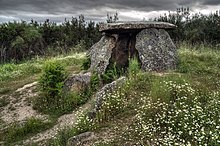Alcantara dolmen
The Dolmen of Alcántara in the Alcántara region in Extremadura in Spain is a group of more than 40 large stone tombs ( dolmen ) . The mostly small dolmens ( similar to the neighboring Portuguese Antas ) are made of granite and slate slabs .
location
The dolmen are located near the border with Portugal in the near and far surroundings of the municipality of Alcántara at heights between approx. 290 and 530 m above sea level. d. The two most striking monuments of the group ( Dolmen de Juan Rol I , Maimón ( Dolmen Maimon II ) and Trincones) are about 1.5 km apart in an east-west direction.
history
The origin of the tombs, originally covered by mounds of earth ( tumuli ) made of stones, earth and grass, dates back to the late Neolithic or early Copper Age (around 4200-3500 BC). Over time, the mounds of earth were removed by natural forces and by human hands.
The dolmens were only discovered for archaeological research by Fernando Tostado in the 1960s and 1970s . In 1980 Cleofe Rivero dug at La Puente and Retamar , but his results are not published. In 1988, Clemente Montano listed 36 dolmens in his work: Aproximación al estudio de los sepulcros megalíticos de Alcántara . The dolmens Maimon I + II , Juan Rol I and Trincones I + II were excavated by Primitiva Bueno Ramírez in 1997 and 1998. The recent cataloging by Antonio Carmona has brought the number of dolmens in Alcántara to seventy-three, which also increases the number of dolmens registered in Zarza la Mayor and Brozas .
Small finds
In contrast to other regions of the Iberian Peninsula , these megalithic systems were also disrupted, but hardly robbed and contained numerous grave goods (axes, ceramics, arrowheads , slate idols , etc.) and thus valuable information on the settlements likely to exist in the vicinity.
Menhir
As is usual on the Iberian Peninsula , there are almost no single large stone monuments ( menhirs ) in the group. The approximately 4.65 m high, erected menhir of Cabezo stands near northeast near the small town of Alcántara and is the only one in this region. It has two larger and several smaller bowl-shaped indentations ( cazoleta (petroglifo) ), which make little sense on an upright stone.
See also
literature
- Clemente Montano Domínguez: Aproximación al estudio de los sepulcros megalíticos de Alcántara. Anales de Adeco, 1988, pp. 28-58.
- Ana Belén Casado Mateos, Amparo Aldecoa Quintana, Primitiva Bueno Ramírez, Rosa Barroso Bermejo, Rodrigo de Balbín Behrmann: Dólmenes en la cuenca del Tajo: restauración y consolidación de megalitos en Alcántara (Cáceres). Trabajos de prehistoria, Vol. 55, No. 1, 1998, pp. 171-183.
- Primitiva Bueno Ramírez, Rodrigo de Balbín Behrmann, Rosa Barroso Bermejo, Ana Belén Casado Mateos, Amparo Aldecoa Quintana: Proyecto de excavación y restauración en dólmenes de Alcántara (Cáceres): Segunda campaña. Trabajos de prehistoria, Vol. 56, No. 1, 1999, pp. 131-146.
- Primitiva Bueno Ramírez, Rodrigo de Balbín Behrmann, Rosa Barroso Bermejo, Amparo Aldecoa Quintana, Ana Belén Casado Mateos: Arte megalítico en Extremadura: Los dólmenes de Alcántara, Cáceres (España). Estudos Pré-Históricos da Beira Alta 7, pp. 85-110.
- Primitiva Bueno Ramírez, Rodrigo de Balbín Behrmann, Rosa Barroso Bermejo, Amparo Aldecoa Quintana, Ana Belén Casado Mateos: Dólmenes en Alcántara (Cáceres): un proyecto de consolidación e información arqueológica en las comarcas extremeñas del Tajo. Balance de las campañas de 1997 y 1998. Extremadura arqueológica No. 8, 2000 (copy dedicado a: El megalitismo en Extremadura (homenaje a Elías Díeguez Luengo)) pp. 129-168.
Web links
- Antonio Carmona: Conjunto Megalítico de Alcántara. (Spanish)
- Dolmen Cajiron II - photos + information (Spanish)
- Dolmen Juan Rol I - short information, photo + location map
Individual evidence
Coordinates: 39 ° 42 '52 " N , 6 ° 52' 57" W.



